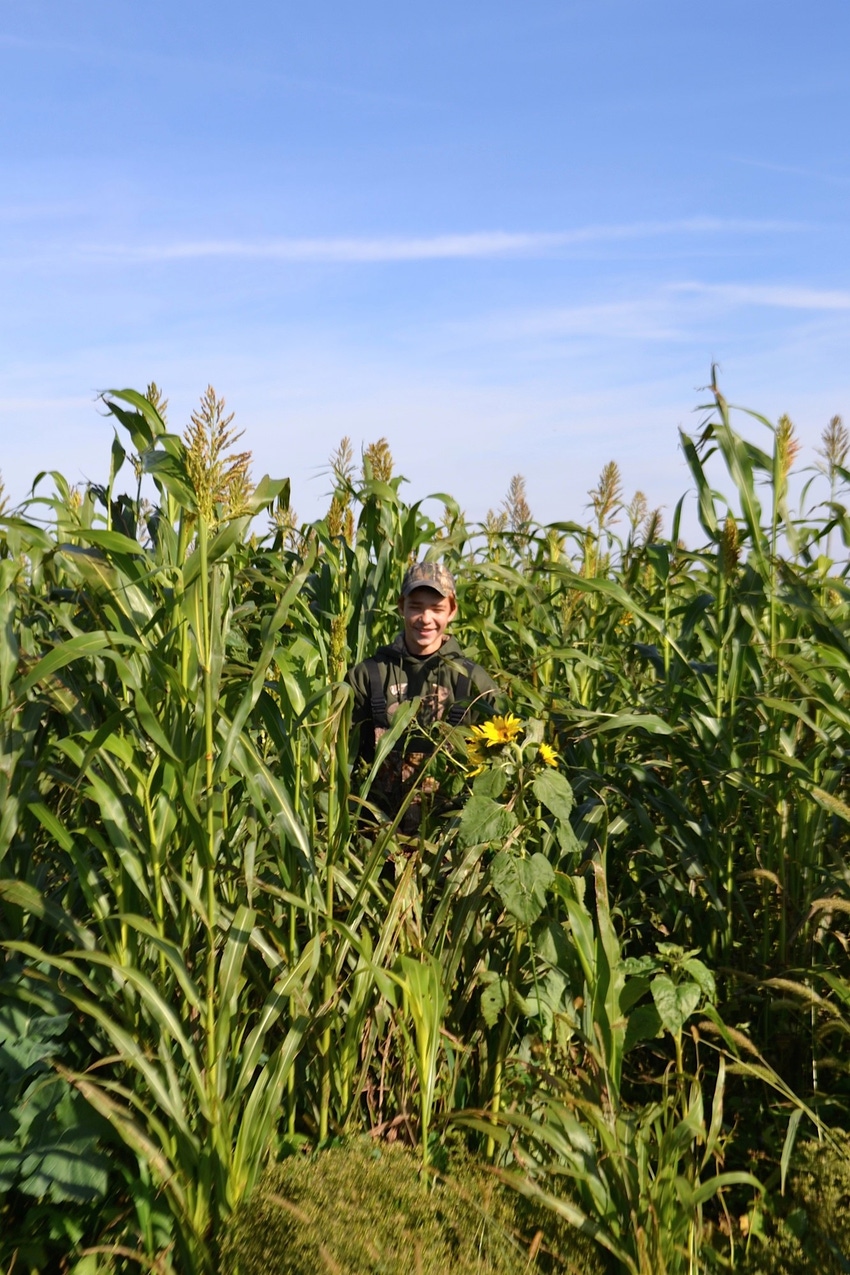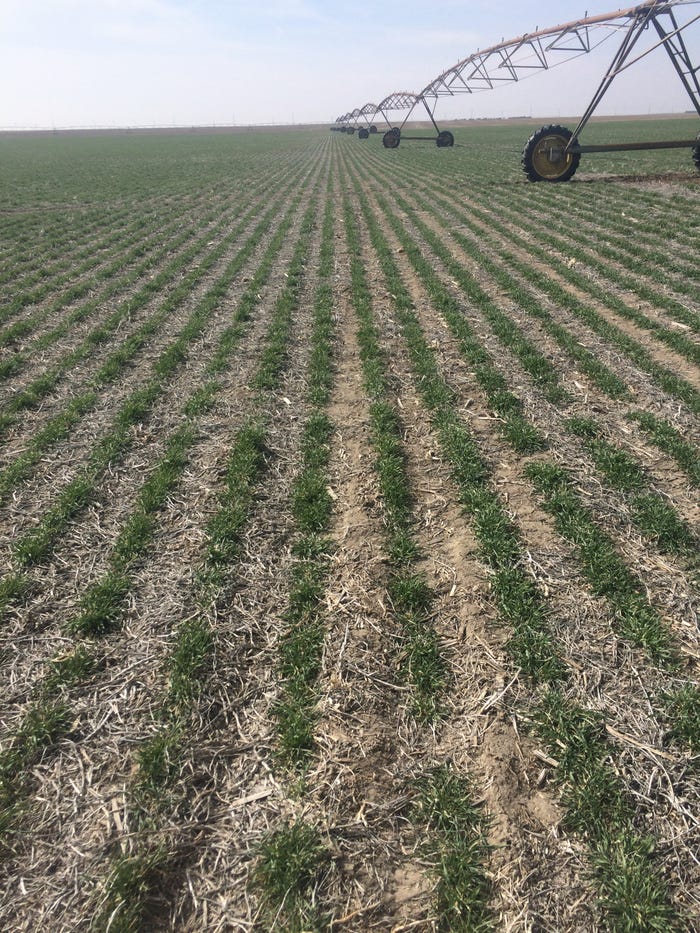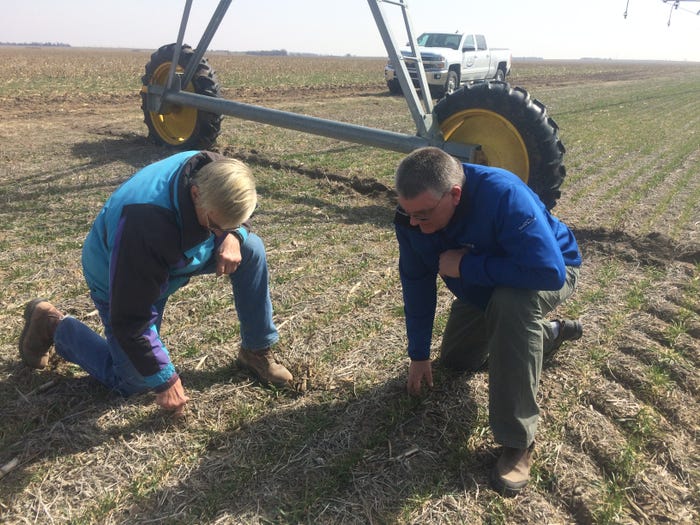April 6, 2017

Think Different
While even a single year of cover crops can provide a benefit, no-till consultant Dan Towery emphasizes that real water storage benefits come with a sustained combination of no-till and cover crops over time. He breaks them into multiple factors:
Cover crops improve aggregate stability of the soil, allowing a hard rain to percolate, rather than run off.
Eliminating tillage also eliminates the loss of 1/2 to 3/4-inch of moisture with every pass.
No-till and cover crops increase organic matter by 1/10 percent of organic matter each per year, which increases water storage capacity by 5,200 gallons per acre per year.
Corn roots only access about two percent of the soil; however, in healthy no-till soils, mycorrhizal fungi hyphae serve as root extensions into macro and micropores, increasing soil contact by a factor of about 20 times.
----------
Dan DeSutter may be planting cover crops, but he's growing water storage, and it pays, even in a near perfect season like 2014. He recalls phenomenal yields that year with averages of 250 bushels an acre, including poor areas hitting 220 bushels. His high organic matter soils did even better, producing yields over 300 bushel. The difference in his west-central Indiana fields was water. 
"We had a three-week period in July with no rain," he says. "The corn in the high organic matter wasn't phased. It never ran out of water."
DeSutter is a longtime no-tiller and cover cropper, but 2014 really got his attention. He quickly realized there is no such thing as a "perfect" year. He now sees the difference that organic matter and soil carbon make every year.
Lost 75% of soil carbon
"We've burned up 75 percent of the soil carbon we started with,” DeSutter says. “But we now know how to build carbon by limiting tillage that oxidizes it, as well as growing roots in the soil. Anytime we have sun and nothing growing is a lost opportunity to put carbon back in the soil."
CHS agronomist Jody Saathoff's clients in Nebrasaka don't believe in missing out on opportunity. They also understand the value of water and cover crops. Limited to only nine inches of irrigation water a year, farmers in south-central Nebraska don't hesitate to hold back an inch to get their cover crops off to a healthy start.

"They know they are raising organic matter and with it, water holding capacity," Saathoff says. "That's important. They can cushion the crop with more moisture and cooler soils."
The linear relationship between organic matter content and water holding capacity is well proven, reports Mahdi Al-Kaisi, professor of agronomy, Iowa State University. "Even in a severe drought like 2012, conservation practices reduced yield loss by 15 to 20 percent," he says. "Organic matter increases soil moisture storage capacity."
Practice no-till, cover crops and/or apply manure and you build the carbon pool, adds Al-Kaisi. The carbon, in turn, reorients or builds soil structure to increase aggregate stability and porosity, which is the volume space available for water storage.
Fine soils store more
"The soil can store a lot of water depending on the type, texture and soil colloids (mostly micro clay particles, but includes decayed organic matter)," says Fred Below, professor, Plant Physiology and Crop Sciences, University of Illinois. "Fine textured soils store more than coarse due to more pore space."
Get more INSIGHT: Download Cover Crops: Best Management Practices now!
While gravity drains water away between coarse soil particles, water held in pores is retained by an attraction between a solid surface and water. Below explains that when soils are at field capacity (after a rain), pores are full of water. As water reserves are depleted, it is the soil colloids that attract and hold water in a thin film around them. Eventually they too give up their water. However, with more carbon/organic matter in the soil, more water is available to begin with. The water storage tank, if you will, is larger.
"It's like you're going to cross a desert," says DeSutter. "Which would you rather have – a six-gallon tank of gas or a 16-gallon tank? With cover crops and no-till, you are growing the size of the tank."
Even a single season of cover crops can make a difference in the size of the tank, notes Dan Towery, field manager for Soil Health Partnership, and no-till consultant with Ag Conservation Solutions, Lafayette, Ind. "In 2012 we had a first-year cover crop grower see a 40-bushel increase over the next field without covers," he recalls. "If we have a dry period in August where the crops are curling on conventional ground, there will be no curling at all in no-till fields with cover crops."

Growers like Bill Nielsen (left) who work with CHS agronomist Jody Saathoff (right) appreciate the larger water reserves available to their crop when planting into cover crops. Limited to only 9 inches of irrigation water a year, Nielsen devotes an inch of it to getting cover crops up and running.
Grow your organic matter
With continuous no-till and cover crops, Towery estimates that over time the increased organic matter and porosity can add three to five additional inches of moisture in the soil profile. That moisture is then available for the crop. Each one percent increase in organic matter adds about 26,000 gallons of available water to an acre.

Grazing cover crops like these puts cash in grower pockets and organic matter in the soil for healthier soil and improved water retention.
While heavy, above ground, biomass cover crops are showy, it is the roots that are vital for building organic matter and water holding capacity, emphasizes Towery. "Above ground material decays and releases CO2 into the atmosphere, but decaying underground material is captured as carbon in the soil," he says. "Combined with root exudated carbon, it increases the water holding micropores and macropores deeper into the soil."
Maximizing water availability is why Saathoff prescribes a mix of 15 or more cover crops, selected for their root mass and carbon to nitrogen ratios from 30 to 50:1. In his area, a dry spring can draw down soil moisture as much as two to three feet below the surface if you don't plant a cover crop. With a cover, the above ground mass cools and mulches the soil surface; below ground, the root mass is doing double duty.
"We armor the soil above ground with biomass while protecting soil moisture from one to five feet deep by bringing moisture up from deeper soils," he says.
Having a deep-rooted cover crop is the equivalent of having tens of thousands of wells in the field. The tendency of water to move means those roots pull water from the deeper soils and release it to the upper soils as they dry out. Exudate and eventual decomposition of the high carbon roots also feed soil microbes and eventually as organic matter take their turn as soil colloids to capture and store water.
Given those benefits, that is why Saathoff's growers will sacrifice an inch of irrigation water to ensure a healthy cover crop. It is less a sacrifice than an investment. Like DeSutter, they know they are growing water.
While heavy, above ground, biomass cover crops are showy, it is the roots that are vital for building organic matter and water holding capacity, emphasizes Towery. "Above ground material decays and releases CO2 into the atmosphere, but decaying underground material is captured as carbon in the soil," he says. "Combined with root exudated carbon, it increases the water holding micropores and macropores deeper into the soil."
About the Author(s)
You May Also Like




